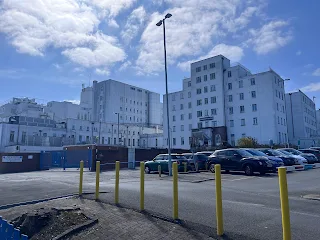
The first likely reason is that St Helier isn't particularly anywhere. You have Morden not too far away, with its Tube connections, a few estates and classic suburban houses with large front gardens, but otherwise...there isn't much else here. The main shopping appeal is the parade on Green Lane, an assortment of barbers and takeaways, with a Londis to boot - so people aren't particularly going to be flocking to St Helier on the Sutton loop in the first place. But for those who want to, they get half hourly trains to the City and up to St Albans, which is albeit not the greatest service but still better than many other places in the UK.
.HEIC)
The second likely reason is that the station isn't really close to St Helier proper. By this I refer to the station being about a kilometre away from St Helier Hospital, which I visited as part of the trip. I didn't enter, obviously, I didn't have a medical emergency midway. However, its exterior alone isn't particularly the most pleasant, looking like stern office blocks from outside.

Construction of the hospital began in 1938, and the first patients were admitted in 1941; throughout the Second World War, the hospital experienced damage from air raid bombing, yet it managed to continue operating. Notable births include future Prime Minister John Major, who supported a campaign to save the hospital in 2007. Queen Mary's Hospital for Children can also be found here - initially founded in Carshalton in 1909, it became the first comprehensive children's hospital in the UK by 1959 before moving to St Helier.

One could argue the hospital belongs to the suburb of Rosehill, which is north of Sutton. Here you'll find the eponymous Rosehill roundabout, where six roads intersect, and is likely the only thing anyone will know about Rosehill. A colourful cylindrical mural will tell you that Rosehill was mostly farmland up until the 1920s, until they built the St Helier estate on it in 1929, naming it for aldermwoman Lady St Helier. They later built shops and flats around the area, before Rosehill grew into the suburb that it is today. Admittedly it has rather amalgamated with the nearby Benhilton and arguably Sutton by now; the local ward is named St Helier West.
Wait...that means there's a St Helier East, surely? And indeed there is - and it's nowhere near St Helier station. In a rare case of forward-planning from me, though, I've been to the surrounding area - the Watermeads Nature Reserve in Mitcham borders it, and that's close enough. See blogpost here.
Back to the station itself, which can be found in the borough of Merton, here are some fun facts that are somewhat related:
- The station itself opened in 1930 when the railway was extended from South Merton to Sutton.
- The Sutton loop has various stations where buses terminate, and St Helier is one of five stations where this is the case, despite only being served by two routes. The S2 terminates at St Helier, and is a rather new route, running since last year. Before then, the S4 ran here since 2006.
- St Helier is one of few London stations named directly after a woman - my assumption it was named for the 6th century saint was wrong. Londonist wrote a piece a few years ago counting about six other stations on the Tube map named for women.
- St Helier isn't the only station named St Helier to have operated in the UK - there have been two St Helier stations in Jersey. However, their railways closed in 1936, so we're left with just this one.
In other words, there isn't much to say about St Helier itself, and the surrounding area is a snapshot of unglamorous suburbia. My Sutton loop exploration will soon be over.

Comments
Post a Comment